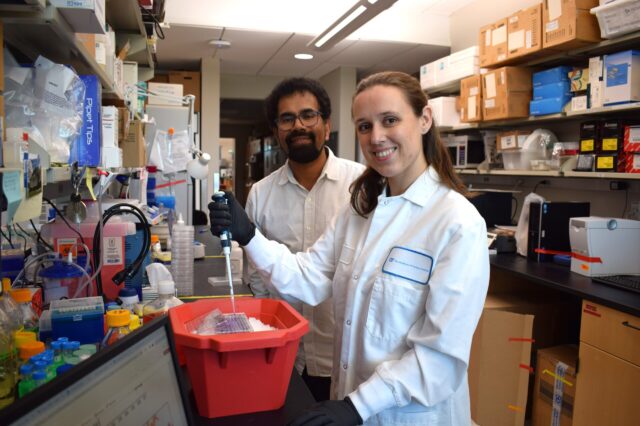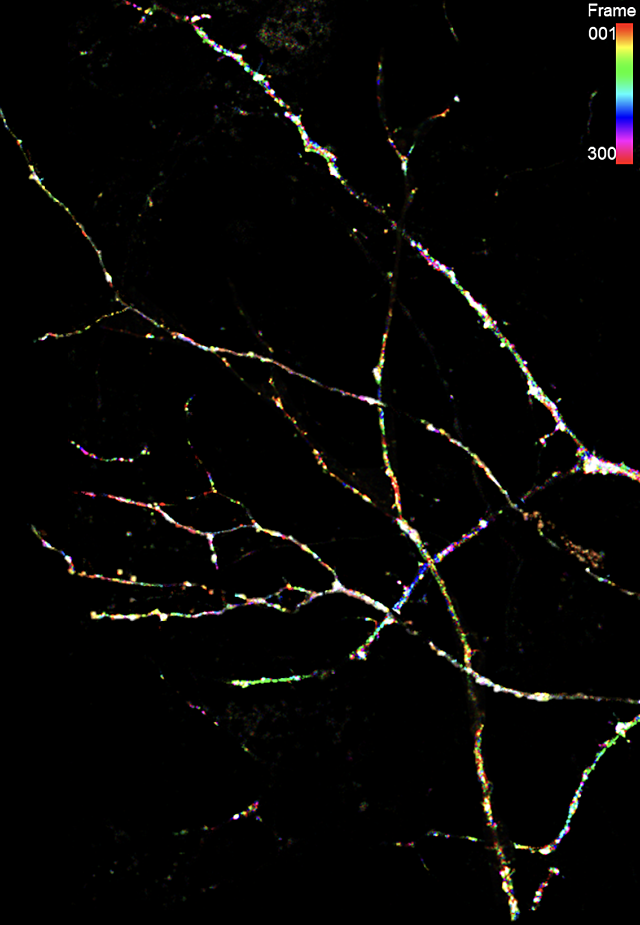Yikes! Scientists discover factor that directs brain’s fear conditioning

Neuroscientist Sathya Puthanveettil, Ph.D., of The Wertheim UF Scripps Institute, joins postdoctoral researcher Jenna Wingfield, Ph.D., in their lab. They discovered a new long noncoding RNA that directs neurons to build connections during fear conditioning.
JUPITER, Fla. — Our brains remember frightening situations to keep us safe in the future. Computer virus from a misspelled email sender? Delete! That bite from a boot bug? Check those shoes.
A team led by neuroscientists at The Herbert Wertheim UF Scripps Institute for Biomedical Innovation & Technology has discovered a key molecular player in fear conditioning. It’s a specialized RNA with a memorable acronym, SLAMR. Their study found SLAMR must be present in adequate quantities for neurons to build the complex connections required for fear conditioning. Their research appears in the journal Nature Communications.
Sathya Puthanveettil, Ph.D., the study’s corresponding author, said the research also adds an important piece to the enormously complex puzzle of how and why neurons deliver such RNAs long distances, to their synapses, the junctions between neurons.
“This actually changes the ways that we think about how synapses work,” Puthanveettil said.
Having the RNA right where it’s needed, at the ends of elongated brain cells, enables the brain’s rapid response to an alarm signal. But how does it move there? The study also discerned the molecular motor, or courier, that neurons use to move SLAMR from cell body to synapse. Coincidentally, the courier, KIF5C, was one discovered by their lab in a 2021 paper. They found it helped neurons build connections during memory formation.
The scientists’ findings raise many questions, including whether changes in SLAMR and its interacting partners may play a role in memory loss, a hallmark of diseases such as Alzheimer’s.
The Alzheimer’s Association estimates that about 580,000 Floridians over age 65 have Alzheimer’s. Nationally, about 7 million people in the United States live with Alzheimer’s. That number is expected to rise to 13 million by 2050, making it an urgently important problem for Florida and the nation to understand and solve, Puthanveettil said. Exploring the molecular workings of learning and memory can provide new insights about such disease processes, he said.
Jenna L. Wingfield, Ph.D., a postdoctoral researcher in Puthanveettil’s group and co-first author on the new study, said despite how it sounds, SLAMR’s name wasn’t chosen because it evoked images of noisy prison doors. Rather, it’s short for “Synaptically Localized Activity Modulated lncRNAs.” The “lncRNA” part of its name is shorthand for “long noncoding RNA,” which are RNA of more than 200 bases not involved in building proteins, but in coordinating certain cell activities.
Other authors include Ryohei Yasuda, Ph.D., scientific director, and Vidhya Rangaraju, Ph.D., group leader, at the Max Plank Florida Institute for Neuroscience; Michael Kiebler, Ph.D., of the Ludwig Maximilian University of Munich, Germany, and members of their labs. The other first author was Isabel Espadas, Ph.D., then a postdoctoral researcher with Puthanveettil’s lab.
Long noncoding RNAs play important roles in managing the activities inside cells. Which ones and precisely how they carry out their duties aren’t well understood, Puthanveettil said. Cells have tens of thousands them.
Their study originated with a discussion Puthanveettil had with Espadas in 2016, about how to search for long noncoding RNAs involved in fear conditioning. The scientists opted for a standard mouse experiment, a mild foot shock, and monitored whether the mice later recalled the experience. Mice that remembered would freeze when reintroduced to the chamber.
Sequencing the RNA from their neurons in specific regions of their brain revealed elevation of SLAMR. More study showed that if it’s not present, mice fail to build densely branched dendrites, leading to fewer synaptic connections, Puthanveettil said. Enriching it created more dense and complex connections. They traced how SLAMR directed production of multiple proteins, and modulated the activity of one specifically involved in memory formation, CaMKII.
This discovery opens many new avenues for further study, Puthanveettil said.
“We need to pinpoint its role in development and disease,” Puthanveettil said. “There are a lot of molecular insights that need to be explored further.”
The study, “Synaptically targeted long non-coding RNA SLAMR promotes structural plasticity by increasing translation and CaMKII activity,” appeared online on March 27, 2024, in the journal Nature Communications. In addition to Wingfield, Espadas, Kiebler, Yasuda, Rangaraju and Puthanveettil, authors included Yoshihisa Nakahta, Ilika Ghosh from the Max Planck Florida Institute for Neuroscience; Kaushik Chanda, Eddie Grinman and Bindu Raveendra from The Herbert Wertheim UF Scripps Institute for Biomedical Innovation & Technology, and Karl E. Bauer from Ludwig-Maximilian University Munich, in Germany.
This research was supported by grants from the National Institutes of Health (5R01MH094607-05,1R21DA039417-01A1, 1F32MH131420-01A1, and 1R01MH119541-01A1), the Max Planck Society and the German Research Foundation.
